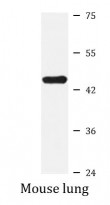ARG42747
anti-TEAD4 antibody
anti-TEAD4 antibody for Western blot and Human,Mouse,Rat
Overview
| Product Description | Rabbit Polyclonal antibody recognizes TEAD4 |
|---|---|
| Tested Reactivity | Hu, Ms, Rat |
| Tested Application | WB |
| Host | Rabbit |
| Clonality | Polyclonal |
| Isotype | IgG |
| Target Name | TEAD4 |
| Antigen Species | Human |
| Immunogen | Recombinant fusion protein corresponding to aa. 110-250 of Human TEAD4 (NP_003204.2). |
| Conjugation | Un-conjugated |
| Alternate Names | TEFR-1; TEA domain family member 4; EFTR-2; Transcription factor RTEF-1; TEF-3; TCF13L1; Transcription factor 13-like 1; TEF3; hRTEF-1B; RTEF1; Transcriptional enhancer factor TEF-3; TEAD-4 |
Application Instructions
| Application Suggestion |
|
||||
|---|---|---|---|---|---|
| Application Note | * The dilutions indicate recommended starting dilutions and the optimal dilutions or concentrations should be determined by the scientist. | ||||
| Positive Control | Mouse lung | ||||
| Observed Size | ~ 46 kDa |
Properties
| Form | Liquid |
|---|---|
| Purification | Affinity purified. |
| Buffer | PBS (pH 7.3), 0.02% Sodium azide and 50% Glycerol. |
| Preservative | 0.02% Sodium azide |
| Stabilizer | 50% Glycerol |
| Storage Instruction | For continuous use, store undiluted antibody at 2-8°C for up to a week. For long-term storage, aliquot and store at -20°C. Storage in frost free freezers is not recommended. Avoid repeated freeze/thaw cycles. Suggest spin the vial prior to opening. The antibody solution should be gently mixed before use. |
| Note | For laboratory research only, not for drug, diagnostic or other use. |
Bioinformation
| Database Links |
Swiss-port # Q15561 Human Transcriptional enhancer factor TEF-3 Swiss-port # Q62296 Mouse Transcriptional enhancer factor TEF-3 |
|---|---|
| Gene Symbol | TEAD4 |
| Gene Full Name | TEA domain family member 4 |
| Background | This gene product is a member of the transcriptional enhancer factor (TEF) family of transcription factors, which contain the TEA/ATTS DNA-binding domain. It is preferentially expressed in the skeletal muscle, and binds to the M-CAT regulatory element found in promoters of muscle-specific genes to direct their gene expression. Alternatively spliced transcripts encoding distinct isoforms, some of which are translated through the use of a non-AUG (UUG) initiation codon, have been described for this gene. [provided by RefSeq, Jul 2008] |
| Function | Transcription factor which plays a key role in the Hippo signaling pathway, a pathway involved in organ size control and tumor suppression by restricting proliferation and promoting apoptosis. The core of this pathway is composed of a kinase cascade wherein MST1/MST2, in complex with its regulatory protein SAV1, phosphorylates and activates LATS1/2 in complex with its regulatory protein MOB1, which in turn phosphorylates and inactivates YAP1 oncoprotein and WWTR1/TAZ. Acts by mediating gene expression of YAP1 and WWTR1/TAZ, thereby regulating cell proliferation, migration and epithelial mesenchymal transition (EMT) induction. Binds specifically and non-cooperatively to the Sph and GT-IIC 'enhansons' (5'-GTGGAATGT-3') and activates transcription. Binds to the M-CAT motif. [UniProt] |
| Cellular Localization | Nucleus. [UniProt] |
| Calculated MW | 48 kDa |
Images (1) Click the Picture to Zoom In






